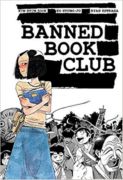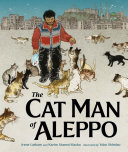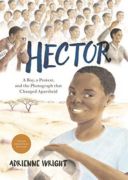A biography of Cuban ballerina Alicia Alonso. Alicia Alonso’s artistic achievements are remarkable, considering that she became partially blind and lost her peripheral vision at age nineteen. From childhood, she exhibited a passion for dancing, studying first in Cuba and later in New York City, where she became an overnight sensation in Giselle and was promoted to principal dancer in Ballet Theater. Returning to Cuba in 1948, she founded her own company, which eventually folded due to lack of funding. In 1959 the Cuban government gave her enough money to establish a new dance school, Ballet Nacional de Cuba, which Alonso directs to this day. In elegant free verse and stunning artwork rendered in watercolor, colored pencils, and lithograph pencils on watercolor paper, Carmen T. Bernier-Grand and Raúl Colón capture the seminal events in Alonso’s life. The back matter includes a biography, Alonso’s ballets, choreography, and awards, a glossary, sources, notes, and websites
Biography – Autobiography- Memoir
Fauja Singh Keeps Going: The True Story Of The Oldest Person To Ever Run A Marathon
“The inspiring true story of Fauja Singh, who broke world records to become the first one hundred-year-old to run a marathon, shares valuable lessons on the source of his grit, determination to overcome obstacles, and commitment to positive representation of the Sikh community”–
Across a Dark and Wild Sea
Columcille was born in a remote corner of Ireland in the year 521. Legend has it that as a child, he was fed a cake filled with the letters of the alphabet, and so learned to love writing. He grew up to become a monk and a scribe a thousand years before the invention of printing, when books had to be copied by hand. There was one book, a beautiful volume of psalms from distant Rome, that Columcille especially loved, and even though its owner refused him permission, Columcille secretly copied it. The copy was discovered, and a dispute arose over who it belonged to: Columcille, who made it, or the owner of the original. So better was the argument that a battle was fought between the two men’s powerful friends; although Columcille’s side won, the victory felt hollow to him. To punish himself, he set out in a tiny boat, vowing to leave Ireland forever.
The Reason I Jump
Written by a very smart, very self-aware, and very charming thirteen-year-old boy with autism, this is a one-of-a-kind memoir that demonstrates how an autistic mind thinks, feels, perceives, and responds in ways few of us can imagine. Parents and family members who never thought they could get inside the head of their autistic loved one at last have a way to break through to the curious, subtle, and complex life within. With disarming honesty and a generous heart, Naoki shares his unique point of view on not only autism but life itself. His insights–into the mystery of words, the wonders of laughter, and the elusiveness of memory–are so startling, so strange, and so powerful that you will never look at the world the same way again. In his introduction, bestselling novelist David Mitchell writes that Naoki’s words allowed him to feel, for the first time, as if his own autistic child was explaining what was happening in his mind. This translation was a labor of love by David and his wife, KA Yoshida, so they’d be able to share that feeling with friends, the wider autism community, and beyond.–From publisher description.
Greta Thunberg (Little People, Big Dreams
When young Greta learned of the climate crisis, she stopped talking. She couldn’t understand why people in power were not doing anything to save our Earth. One day she started protesting outside the Swedish Parliament, creating the “School Strike for Climate.” Soon, lots more young people joined her in a global movement that shook adults and politicians alike. She had found her voice and uses it to inspire humans to action with her powerful message: “No one is too small to make a difference.” This inspiring book features stylish and quirky illustrations and extra facts at the back, including a biographical timeline with historical photos and a detailed profile of the climate activist’s life.
King Shaka
Shaka has fought his brother to the death for rulership of the Zulu. Now king of the southern chiefdoms, Shaka seeks to uplift his people, consolidate alliances, and expand the reach of his power. But challenges both external and internal threaten his rule. A rogue military unit exacts revenge on its enemies. Land-hungry Europeans arrive and ingratiate themselves with Shaka, even while plotting their own path to power. And closer to home, Shaka’s own brothers conspire in secret.
Girl On A Motorcycle
One day, a girl gets on her motorcycle and rides away. She wants to wander the world. To go . . . Elsewhere. This is the true story of the first woman to ride a motorcycle around the world alone. Each place has something to teach her. Each place is beautiful. And despite many flat tires and falls, she learns to always get back up and keep riding.
Banned Book Club

A Junior Library Guild Selection When Kim Hyun Sook started college in 1983 she was ready for her world to open up. After acing her exams and sort-of convincing her traditional mother that it was a good idea for a woman to go to college, she looked forward to soaking up the ideas of Western Literature far from the drudgery she was promised at her family’s restaurant. But literature class would prove to be just the start of a massive turning point, still focused on reading but with life-or-death stakes she never could have imagined. This was during South Korea’s Fifth Republic, a military regime that entrenched its power through censorship, torture, and the murder of protestors. In this charged political climate, with Molotov cocktails flying and fellow students disappearing for hours and returning with bruises, Hyun Sook sought refuge in the comfort of books. When the handsome young editor of the school newspaper invited her to his reading group, she expected to pop into the cafeteria to talk about Moby Dick, Hamlet, and The Scarlet Letter. Instead she found herself hiding in a basement as the youngest member of an underground banned book club. And as Hyun Sook soon discovered, in a totalitarian regime, the delights of discovering great works of illicit literature are quickly overshadowed by fear and violence as the walls close in. In BANNED BOOK CLUB, Hyun Sook shares a dramatic true story of political division, fear-mongering, anti-intellectualism, the death of democratic institutions, and the relentless rebellion of reading.
The Cat Man Of Aleppo

The courageous and true story of Mohammad Alaa Aljaleel, who in the midst of the Syrian Civil War offered safe haven to Aleppo’s abandoned cats. Aleppo’s city center no longer echoes with the rich, exciting sounds of copper-pot pounding and traditional sword sharpening. His neighborhood is empty–except for the many cats left behind. Alaa loves Aleppo, but when war comes his neighbors flee to safety, leaving their many pets behind. Alaa decides to stay–he can make a difference by driving an ambulance, carrying the sick and wounded to safety. One day he hears hungry cats calling out to him on his way home. They are lonely and scared, just like him. He feeds and pets them to let them know they are loved. The next day more cats come, and then even more! There are too many for Alaa to take care of on his own. Alaa has a big heart, but he will need help from others if he wants to keep all of his new friends safe.
The Cat Man of Aleppo is a WOW Recommends: Book of the Month for May 2021.
Hector; a boy, a protest, and the photograph that changed apartheid

On June 16, 1976, Hector Pieterson, an ordinary boy, lost his life after getting caught up in what was supposed to be a peaceful protest. Black South African students were marching against a new law requiring that they be taught half of their subjects in Afrikaans, the language of the White government. The story’s events unfold from the perspectives of Hector, his sister, and the photographer who captured their photo in the chaos. This book can serve as a pertinent tool for adults discussing global history and race relations with children. Its graphic novel style and mixed media art portray the vibrancy and grit of Hector’s daily life and untimely death. Heartbreaking yet relevant, this powerful story gives voice to an ordinary boy and sheds light on events that helped lead to the end of apartheid.
